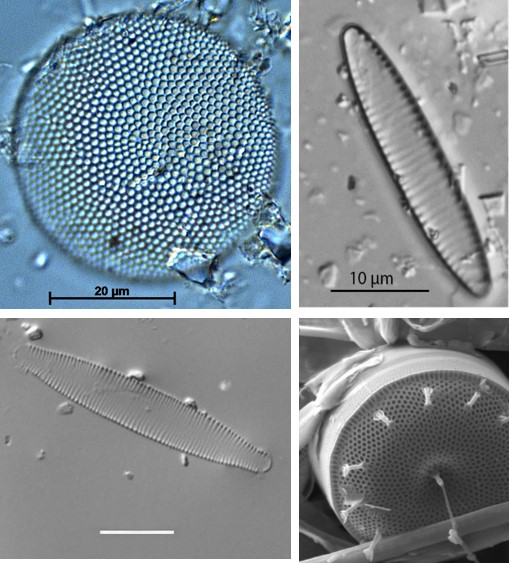- Home
- Publications
- PAGES Magazine
- Harmonizing Marine Arctic Diatom Taxonomy For Improving Paleoenvironmental Reconstructions
Harmonizing marine Arctic diatom taxonomy for improving paleoenvironmental reconstructions
Mimmi Oksman, T. Luostarinen, A. Limoges, B. Caissie, C. Pearce and K. Weckström
Past Global Changes Magazine
31(2)
126
2023
2nd MARDI workshop, Helsinki, Finland, 6–8 June 2023
Marine diatoms are highly sensitive to changes in their environment, such as changes in temperature, salinity, and sea ice, which has made them a widely used proxy for paleoenvironmental reconstructions (Koç Karpuz and Schrader 1990; Miettinen et al. 2015; Oksman et al. 2019). For a long time, fossilized diatoms have been used to produce qualitative reconstructions of past climate. In the late 1980s, the demand for quantitative paleodata by the modeling community promoted the development of modern diatom calibration datasets (Caissie et al. 2012; Koç Karpuz and Schrader 1990; Krawczyk et al. 2017; Miettinen et al. 2015) that enabled quantitative estimates of past sea-surface conditions. The development of calibration datasets has been fast since the early 1990s. Today, several diatom datasets exist from the (sub)Arctic regions, together including more than a thousand surface-sediment samples. Each dataset includes information about modern diatom assemblages in the surface-sediment and modern surface-ocean environmental data from the same location. These calibration datasets also allow the study of species autecology, knowledge of which is essential for the robustness of diatoms as a paleo proxy.
However, slightly different methodologies and taxonomies have been used to build these datasets, as they were gathered by different independent research groups. This can lead to inconsistencies in diatom-based climate records. The MARDI (Marine Arctic Diatoms) working group (WG) (pastglobalchanges.org/mardi) was launched in November 2022 to integrate and harmonize the various datasets into one open-access database. Read more about MARDI objectives and activities in this issue (p. 112).
On 6–8 June 2023, 17 diatom enthusiasts (40% early-career researchers) from 10 countries (Canada, Chile, Denmark, Finland, Greenland, India, Italy, Sweden, Turkey, and USA) gathered in Helsinki, Finland, for the 2nd MARDI workshop with the title “Harmonization of (sub)Arctic diatom taxonomy” (pastglobalchanges.org/calendar/136750). The main aim of this workshop was to agree upon the identification criteria of common Arctic diatom taxa – a first critical step to enable integration of the different datasets. Prior to the workshop, about 30 of the most common and taxonomically challenging high-latitude diatom species were listed (Fig. 1). During the workshop, each species was individually discussed, with focus on key features for identification. While consensus was achieved among participants on the majority of the species, important issues that still need to be solved were raised for some. For example, what has previously been identified as the vegetative cell of Bacterosira bathyomphala in sediment stratigraphies could in fact be the primary valve of the heterovalvate resting spore. Such issues can have a significant relevance to paleoenvironmental reconstructions if vegetative cells and resting stages represent different ecological conditions.
 |
|
Figure 1: Common Arctic diatom taxa were described and discussed in the taxonomic session of the MARDI workshop. Photo credits: Beth Caissie, Christof Pearce and Mimmi Oksman. |
A second important topic of the workshop was to discuss different sample-preparation methods and evaluate if certain methods/practices can influence the diatom assemblage by favoring particular physical features (e.g. highly silicified or small/large valves). The common diatom microscopy slide preparation methods were presented, followed by a discussion of their possible (dis)advantages. MARDI has designed an interlaboratory comparison and counting exercise to test disagreement between different methodologies and the statistical reproducibility of sample preparation. Diatom slides for microscopic identification were prepared by workshop participants following the most common methodologies used by diatomists, and these will be analyzed according to the protocol agreed upon during the workshop. Findings from this exercise will be presented in a future publication.
On the third workshop day, participants performed an identification and slide counting practice to test if there were significant identification differences when counting a diatom microscope slide without taxonomic keys, and with limited time for identification. This exercise provided amusement, but also important insight into how challenging diatom taxonomy is, and hence, the element of subjectiveness involved in identification.
The main outcome of the workshop was the agreement on the taxonomy of the main ecologically relevant taxa, and identification of the knowledge gaps that might affect diatom reconstructions. High-quality images of the taxa discussed at the workshop will be uploaded to an open-access database (diatoms.org), with inclusion of detailed descriptions of species morphology and key identification features. This tool will then be available for everyone working with marine Arctic diatoms. For some species, discussions will continue in the form of mini-workshops that MARDI will organize in the upcoming months. These mini-workshops will consist of half to one-day online meetings open to everyone.
Acknowledgements
The MARDI WG wishes to thank PAGES for financially supporting this workshop, as well as the Ecosystems and Environment Research Programme, University of Helsinki, for hosting us during the workshop.
affiliationS
1Department of Glaciology and Climate, Geological Survey of Denmark and Greenland, Copenhagen, Denmark
2Environmental Change Research Unit, Ecosystems and Environment Research Programme, University of Helsinki, Finland
3Department of Earth Sciences, University of New Brunswick, Fredericton, Canada
4Geology, Minerals, Energy, and Geophysics Science Center, United States Geological Survey, Menlo Park, USA
5University of California, Santa Cruz, USA
6Department of Geoscience, Aarhus University, Denmark
contact
Mimmi Oksman: mio geus.dk
geus.dk
References
Caissie BA (2012) PhD Thesis, University of Massachusetss Amherst, 213 pp
Koç Karpuz N, Schrader H (1990) Paleoceanography 5(4): 557-580
Krawczyk DW et al. (2017) Paleoceanography 32: 18-40
